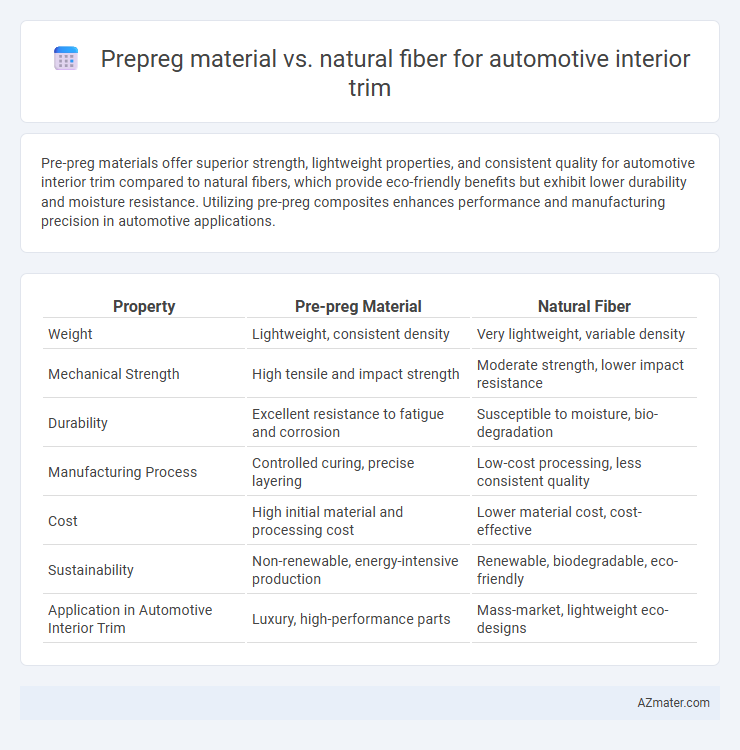Pre-preg materials offer superior strength, lightweight properties, and consistent quality for automotive interior trim compared to natural fibers, which provide eco-friendly benefits but exhibit lower durability and moisture resistance. Utilizing pre-preg composites enhances performance and manufacturing precision in automotive applications.
Table of Comparison
| Property | Pre-preg Material | Natural Fiber |
|---|---|---|
| Weight | Lightweight, consistent density | Very lightweight, variable density |
| Mechanical Strength | High tensile and impact strength | Moderate strength, lower impact resistance |
| Durability | Excellent resistance to fatigue and corrosion | Susceptible to moisture, bio-degradation |
| Manufacturing Process | Controlled curing, precise layering | Low-cost processing, less consistent quality |
| Cost | High initial material and processing cost | Lower material cost, cost-effective |
| Sustainability | Non-renewable, energy-intensive production | Renewable, biodegradable, eco-friendly |
| Application in Automotive Interior Trim | Luxury, high-performance parts | Mass-market, lightweight eco-designs |
Introduction to Automotive Interior Trim Materials
Pre-preg materials, reinforced with carbon or glass fibers impregnated with thermoset resin, offer superior strength-to-weight ratio and dimensional stability for automotive interior trim, enhancing durability and aesthetic appeal. Natural fibers like hemp, flax, and jute provide sustainable alternatives by reducing environmental impact and weight while maintaining adequate mechanical properties. Selecting between pre-preg composites and natural fiber materials depends on performance requirements, cost efficiency, and eco-friendly objectives in automotive interior trim manufacturing.
Overview of Pre-preg Materials
Pre-preg materials, composed of fibers pre-impregnated with resin systems like epoxy, offer superior strength-to-weight ratios and consistent mechanical properties ideal for automotive interior trim applications. These materials enable precise control over fiber orientation and resin content, resulting in enhanced durability, reduced weight, and improved dimensional stability compared to natural fibers. Their use supports advanced manufacturing processes such as vacuum bagging and autoclave curing, ensuring high-quality, high-performance interior components.
Understanding Natural Fiber Composites
Natural fiber composites in automotive interior trim offer lightweight, sustainable alternatives to traditional pre-preg materials by combining fibers such as flax, hemp, or jute with bio-based or synthetic resins. These composites provide favorable mechanical properties, improved acoustic insulation, and reduced carbon footprint, aligning with increasing environmental regulations and consumer demand for eco-friendly vehicles. Advances in fiber treatment and resin compatibility enhance the durability and performance of natural fiber composites, making them viable substitutes for conventional pre-preg materials in automotive interior applications.
Mechanical Performance Comparison
Pre-preg materials exhibit superior mechanical performance in automotive interior trim applications, offering enhanced strength-to-weight ratios, high stiffness, and excellent impact resistance compared to natural fibers. Natural fibers like flax or hemp provide moderate tensile properties and improved sustainability but typically fall short in terms of durability, fatigue resistance, and dimensional stability under automotive operating conditions. The choice between pre-pregs and natural fibers hinges on balancing performance requirements with environmental considerations, where pre-pregs dominate in high-load, safety-critical components.
Weight and Sustainability Considerations
Pre-preg materials, typically carbon or glass fiber reinforced polymers, offer superior weight reduction for automotive interior trim due to their high strength-to-weight ratios, enhancing fuel efficiency and performance. Natural fibers, such as flax or hemp, provide sustainability advantages with biodegradability and lower embodied energy, aligning with green automotive initiatives and reducing environmental impact. Balancing pre-preg composites' lightweight benefits against the ecological advantages of natural fibers is crucial in advancing eco-friendly yet high-performance automotive interiors.
Cost Analysis: Pre-preg vs Natural Fiber
Pre-preg materials typically incur higher upfront costs due to advanced manufacturing processes and specialized resin systems, making them more expensive than natural fibers for automotive interior trim applications. Natural fibers such as flax, hemp, or jute offer cost-effective alternatives by reducing raw material expenses and energy consumption during production. Despite higher initial investments, pre-preg composites deliver superior mechanical properties and consistent quality, which may lower long-term maintenance and replacement costs compared to natural fiber counterparts.
Aesthetic and Design Flexibility
Pre-preg materials offer superior design flexibility and consistent aesthetic quality due to their uniform resin distribution and ability to be molded into complex shapes with smooth finishes, ideal for high-end automotive interior trims. Natural fibers provide unique textures and eco-friendly appeal, allowing for innovative, tactile designs that emphasize sustainability, though they may present variability in appearance and limited molding capabilities. Combining pre-preg composites with natural fiber reinforcements can achieve a balance of durability, visual appeal, and customizable design options in automotive interiors.
Environmental Impact and Recyclability
Pre-preg materials, typically composed of synthetic fibers embedded in a resin matrix, exhibit higher strength and durability but pose challenges in recyclability due to thermoset resin properties, leading to less environmentally friendly disposal options. Natural fibers such as flax, hemp, or jute offer significant environmental benefits, including biodegradability, lower carbon footprint during production, and ease of recycling or composting after vehicle lifespan. Incorporating natural fiber composites in automotive interior trim reduces reliance on petrochemical-based materials, enhancing sustainability and enabling more circular economy practices within the automotive industry.
Processing and Manufacturing Challenges
Pre-preg materials offer superior consistency and enhanced mechanical properties for automotive interior trim but require controlled curing environments and precise handling to prevent defects during processing. Natural fibers present challenges such as moisture absorption, variability in fiber quality, and compatibility issues with resin matrices, which complicate manufacturing and affect the reliability of finished components. The trade-off between the energy-intensive processing of pre-pregs and the sustainable but less predictable behavior of natural fibers remains a critical consideration for automotive manufacturers.
Future Trends in Automotive Interior Trim Materials
Pre-preg materials offer enhanced strength-to-weight ratios and consistent quality, making them ideal for future automotive interior trim focused on lightweight performance and durability. Natural fibers like hemp and flax are gaining traction for their renewable properties and ability to reduce vehicle carbon footprints while maintaining acceptable mechanical properties. The trend is moving towards hybrid composites that combine pre-preg carbon fibers with natural fibers to optimize sustainability and structural integrity in next-generation automotive interior components.

Infographic: Pre-preg material vs Natural fiber for Automotive interior trim
 azmater.com
azmater.com